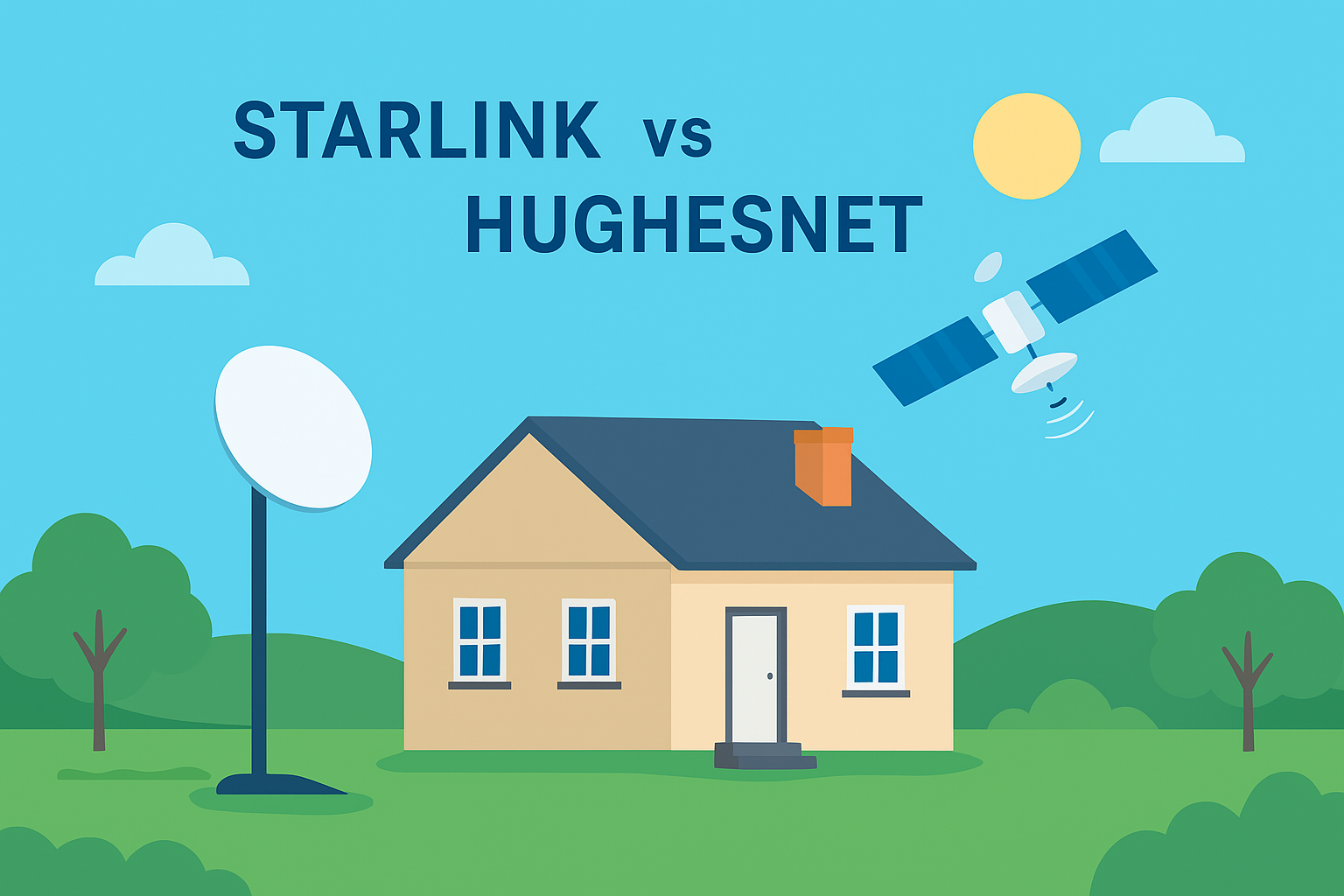DEALER
Proven Sales Strategies for New HughesNet Dealers
Understanding the HughesNet Advantage HughesNet is a household name when it comes to satellite internet....
Learn More

![]() October 23, 2025
October 23, 2025
Compare Starlink vs. HughesNet in terms of speed, latency, coverage, and pricing to find the best satellite internet provider for rural or remote areas.
If you live in a rural location with no access to fiber or cable, satellite internet may be your best option for staying connected. Two of the most recognized names in this space are Starlink, launched by SpaceX, and HughesNet, a long-established satellite provider.
While both offer internet via orbiting satellites, they operate very differently. Starlink uses a growing constellation of low Earth orbit satellites, while HughesNet relies on a few large geostationary satellites much farther from Earth. This difference has a huge impact on speed, latency, and overall performance.
Starlink and HughesNet take different approaches when it comes to service coverage.
Starlink is rapidly expanding its reach, already covering much of the U.S., Canada, and several other countries. Its low Earth orbit satellites allow for high-speed connectivity even in remote areas. The company’s long-term goal is global coverage — and it’s quickly getting there.
In contrast, HughesNet offers wide availability across the Americas by using satellites positioned in geostationary orbit. While this gives HughesNet a head start in coverage, it also means higher latency and slower speeds, particularly in rural regions.
If you want to learn how HughesNet supports businesses and entrepreneurs, check out our article: Why Become a HughesNet Reseller?
Speed is where Starlink clearly leads.
During peak hours, Starlink maintains more consistent speeds thanks to its distributed satellite network, while HughesNet users often experience throttling and congestion.
For those who stream, game, or work online, Starlink’s faster speeds and stability make it a more reliable option.
Latency — the time it takes data to travel from your device to the satellite and back — is crucial for real-time tasks like gaming or video calls.
Because Starlink’s satellites orbit closer to Earth, it delivers latency as low as 20–40ms. HughesNet, using geostationary satellites, averages 600ms or higher.
That difference means Starlink users enjoy smoother video calls, less buffering, and playable online games, while HughesNet users may face noticeable delays.
If you rely on video conferencing or remote work tools, this low-latency performance gives Starlink a major edge.
When it comes to uptime, Starlink’s newer technology offers an advantage.
Starlink uses advanced laser-linked satellites to maintain steady connections, even when some satellites are obstructed. Meanwhile, HughesNet requires an uninterrupted line of sight to its satellite — any interference from weather or obstacles can cause drops.
HughesNet customers also report more frequent outages, especially during heavy rain or high usage periods. Starlink’s modern design makes it more resilient to weather and capable of handling congestion more effectively.
Data limits are another key area of difference.
While HughesNet offers some “off-peak unlimited data” at night, it’s limited in speed and practicality. For heavy users, Starlink’s freedom from strict data caps is a major plus.
Starlink’s residential plan costs $110/month, with no contract commitments.
HughesNet offers plans from $59.99 to $149.99/month, but requires a 2-year contract.
Starlink includes equipment in the service price, while HughesNet charges an additional $99–$299 upfront for hardware and installation.
Both occasionally offer discounts. Starlink sometimes waives setup fees, and HughesNet often promotes free installation for new customers.
For a detailed comparison of HughesNet’s traditional offerings, see our guide: HughesNet vs. Traditional Cable Internet: Which is Right for You?
Customer support varies between the two providers.
Starlink, being newer, handles support primarily through email and online help centers. Early reports suggest quick turnaround times and streamlined issue resolution.
HughesNet, with its larger customer base, offers 24/7 phone and chat support, but reviews often mention long wait times.
So far, Starlink’s smaller user pool gives it a slight edge in customer satisfaction, though HughesNet’s round-the-clock phone service may appeal to those who prefer live assistance.
Both services require a dish and router setup, but Starlink’s is more modern.
Starlink’s sleek, self-aligning dish is compact and easy to install, using advanced beamforming technology to track satellites.
HughesNet’s dish is larger, relies on older hardware, and typically requires professional installation.
Starlink’s included router supports modern Wi-Fi standards and integrates seamlessly with the dish. HughesNet routers, while functional, lack the same advanced networking features.
When comparing Starlink vs. HughesNet, the choice comes down to performance versus availability.
If Starlink is available in your area, it offers faster speeds, lower latency, and no strict data limits — ideal for streaming, gaming, or working remotely. HughesNet remains a dependable choice for regions not yet covered by Starlink, especially where coverage reliability is the top concern.
As Starlink expands, it’s quickly becoming the top satellite internet option for rural users, offering a glimpse of the future of global broadband connectivity.

Smart Ways to Improve Your Credit Score Across Any Credit-Monitoring Platform
Oct 31, 2025

Is Your Dealer Legit? Here’s How to Find Out
Oct 30, 2025

Thinking About Upgrading Your Brinks Home Security System?
Oct 28, 2025

Spectrum Mobile Review: Pros, Cons, and Everything You Need to Know
Oct 27, 2025

Starlink vs HughesNet: Which Satellite Internet is Right for You?
Oct 23, 2025